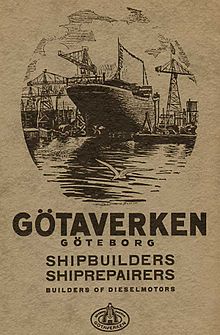Götaverken Cityvarvet
The Swedish conversion and repair yard Götaverken Cityvarvet AB in Gothenburg goes back to a predecessor company from 1841. During the time of its existence, numerous different types of ships and ship engines were created . In addition to the construction of large series ships , the company has also made a name for itself in special shipbuilding.
history
Foundation by Alexander Keiller
The roots of the shipyard go back to the company founded in 1841 by the Scottish entrepreneur Alexander Keiller as Keillers Werkstad i Göteborg . After the company had initially worked as a general metal construction company for a few years (among other things, cast-iron windows were manufactured under the Ferro brand ), the experience in iron shipbuilding was implemented and the first ship was launched in 1847. After Keiller's bankruptcy in 1867, the company was converted into a stock corporation and has since operated under the name Göteborgs Mekaniska Verkstads AB . In 1906 the name was changed after a majority change to Göteborgs Nya Verkstads AB and the company expanded. Another ten years later, the production of diesel engines began under license from the Danish manufacturer Burmeister & Wain and the next change to the best-known name, AB Götaverken . The company also grew in the following decades and in the 1930s was one of the most productive shipbuilding companies in the world. From 1939 self-developed diesel engines were offered under the name Götaverken Motor .
Post war history
The decades after the Second World War were marked by further growth and from 1950 by the construction of a completely new shipyard in Arendal. The newly built and at the time ultra-modern operation was completed in the first half of the 1960s and focused primarily on the series production of large ship units such as tankers and bulk carriers . Shipbuilding on the old company ended after the bulk carrier Greta Thulin was delivered in 1968.
In 1971 the Salén shipping company took over the shipyard company. Due to the oil crisis of 1973 , Salén was forced to integrate Finnboda AB, which also belongs to the shipping company, into Götaverken in 1974, to give up the in-house development of diesel engines (licensed buildings from Burmeister & Wain continued until 1990) and to give up the manufacture of windows. In 1976 the Götaverken group was split up into individual companies. Engine construction went to Svenska Bearing AB and shipbuilding was taken over by the state-owned Svenska Varv in 1977 with the subsidiary Götaverken Finnboda AB . After the demand for the previously produced tankers and bulkers had fallen sharply, the shipyard was converted to ship repairs and maintenance from the mid-1970s to the early 1980s, and the workforce was reduced from 2,243 employees in 1976 to 1,483 at the end of 1981. In addition, later attempts were made to survive by building more complex types of ships, such as ferries , icebreakers or refrigerated ships . After the icebreaker Oden was delivered in 1989, shipbuilding ceased and the Arendal shipyard closed. In 1993 the remaining city shipyard (Cityvarvet) went bankrupt after a long period of drought, but was able to reopen with a considerably reduced workforce of 70 men. Over the years, the number of employees rose to 140. Since 2000, the company has been part of the Damen Shipyards Group and is operated as a ship repair yard with several of its own floating docks .
The outsourced engine construction went bankrupt on March 24, 2003, and the facilities in Trollhättan were later continued to be used by Wärtsilä .
In 2013, Cityvarvet's workforce was reduced from 125 to 65. In April 2014, the operator group announced that they would be handling the shipyard operations.
Web links
- Side of the business (English)
- Side of the business with ladies (English)
- History page varvshistoriska (Swedish)
Individual evidence
- ↑ Cityvarvet's repair concept should secure the future . In: ship and harbor / command bridge . Volume 34, Issue 9. Seehafen-Verlag Erik Blumenfeld, Hamburg September 1982, p. 171 .
- ↑ Varvsepok går i graven (Swedish), üs: Shipyard era is buried. (No longer available online.) Göteborgs-Posten , April 24, 2014, archived from the original on October 11, 2014 ; Retrieved April 24, 2014 . Info: The archive link was inserted automatically and has not yet been checked. Please check the original and archive link according to the instructions and then remove this notice.


